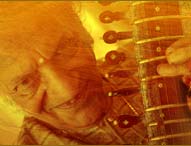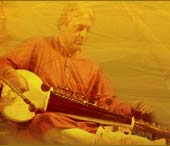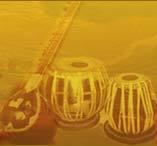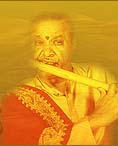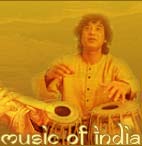Mridangam is an Indian classical drumming instrument which is much popular in South India. The word 'Mridangam' is derived from the Sanskrit words 'mrda' and 'anga' that means 'Body of Clay', and also indicates that initially it was made of clay. Mridangam is the main musical instrument that provides rhythm to Carnatic music performances. Mridangam is also recognized by different names like Mrudangam, Mrdangam, Mrithangam, Miruthangam And Mirudhangam. It is played from both the sides. The instrument is usually made from wood of jackfruit tree. A hollow piece of wood is taken of about an inch thickness and is covered with leather on both the sides. These leather straps tied on the edge of the Mridangam are stretched to high tension on either side of the hull, which allows them to vibrate when struck. It is important to note that both the layers are different in size, which helps in production of both bass and treble sounds from the Mridangam. The 'thoppi' or 'edabhaaga' is low-pitched aperture whereas the 'valanthalai' or 'balabhaaga' is high-pitched aperture. The small part of the Mridangam when struck with a stick produces high-pitched sound whereas the bigger part produces low-pitched sound. Leather that covers the smaller layer is tarnished in the center with a black round spot which is made of rice flour, starch and ferric oxide. This black mixture is known as the 'satham' or 'karnai' which gives the Mridangam its distinctive metallic tone. In North India, Mridangam is known by the name of 'pakhawaj' but a little difference has been observed in both Mridangam and pakhawaj. In Bengal and Manipur, mridangam is commonly known as 'khol'.
History of Mridangam
According to Hindu mythology, it is said that Nandi (the vehicle and friend of Lord Shiva) played the Mridangam at the time when Lord Shiva performed Tandava dance. The sound of the instrument was such that divine rhythm reverberated across the heavens. Mridangam is also the playing instrument of Lord Ganesha. Thus, it is often known as 'Deva Vaadyam' (the musical instrument of God). Mridangam was one of the most significant drums at the time of Bharata. It was one of the triumvirate-Mridangam, Panava and Dardura. Today, it is one of the best and famous percussion instruments. It is also known as the classical drum of South India which is used in presenting South Indian Classical Music and dance. Mridangam is also known as the 'King of Percussion Instruments'.
Occasions
Mridangam is mainly used in presenting Carnatic music. It is the most important instrument used in Indian classical music. Mridangam is also used as an accompanying musical instrument in 'Yaksha Gana'. Nowadays, it is played in every Carnatic music concert held in India or other parts of the world including Malaysia, Sri Lanka, Canada, United Kingdom, Australia and United States. At the time of drumming instruments ensemble, Mridangam is supported with the Ghatam, Kanjira and the Morsing.
Famous Mridangam Players
Pazhani Subramanya Pillai was as a great Mridangam player. Trichy Sankaran is known as one of the leading geniuses of the Mridangam. Karaikudi R. Mani is amongst the most popular South Indian Mridangam players. Some of the other famous mridangam players are Dr. T. K. Murthy, Umayalapuram K. Sivaraman, Vellore Ramabhadran, Yella Venkateswara Rao, Srimushnam Raja Rao and Tiruvarur Bhaktavatsalam.
